|
The great majority of artifacts recovered during archeological surveys of Davids Island date to the second half of the 19th century and the first half of the 20th century. These were usually small and fragmentary, characteristics that indicated they came from soils that had been disturbed repeatedly by construction and landscaping.
The most numerous types of artifacts on Davids Island were architectural fragments of nails, window glass, brick and tile fragments. Sherds of different kinds of pottery, such as earthenware, stoneware and porcelain, along with fragments of bottles and other glassware were also common. Other kinds of artifacts, such as buttons, furniture hardware, expended small-arms ammunition, coins, tobacco pipes, and so on, were relatively uncommon.
Historic Artifacts
Davids I Brick AnchorOne of the million or more bricks used by the Army to build Fort Slocum. This example, from the edging of a sidewalk, has a raised anchor as a maker's mark and probably dates to the 1880s. 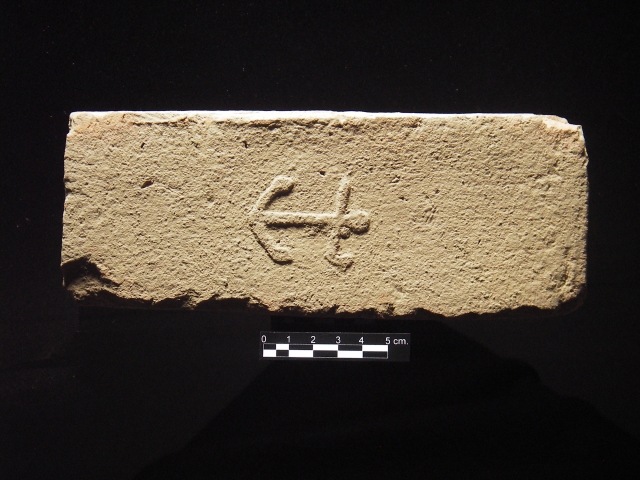  Davids I Button ExamplesExamples of military uniform buttons found during the 2005-2006 archeological survey of Davids Island. This group includes (left to right) a small sleeve button; a First World War machine gun company collar button; and three blouse, jacket or pocket buttons, including one dating to the Civil War (far right). 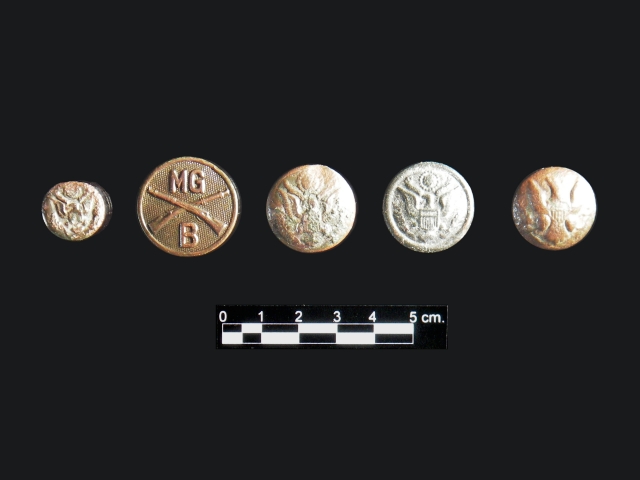  Davids I Ceramic ExamplesSherds of several types of 19th-century pottery found during the 2005-2006 archeological survey of Davids Island, including gray salt-glazed stoneware (top) and pearlware, redware with flat slip-trailing, and Rockingham-type yellowware (bottom, left to right). 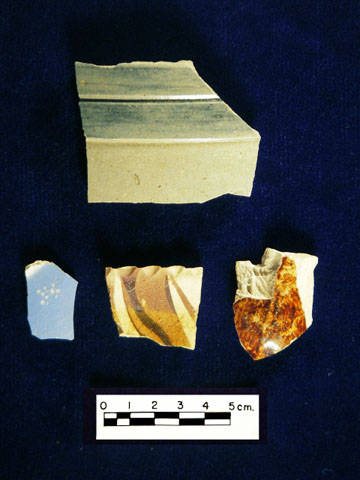  Davids I Coin ExamplesExamples of coins recovered during the 2005-2006 archeological survey of Davids Island. Left to right are 1946 U.S. nickel; 1954 Republic of India 1-pice coin; 1899 U.S. Indian-head cent; and 1838 U.S. large cent. 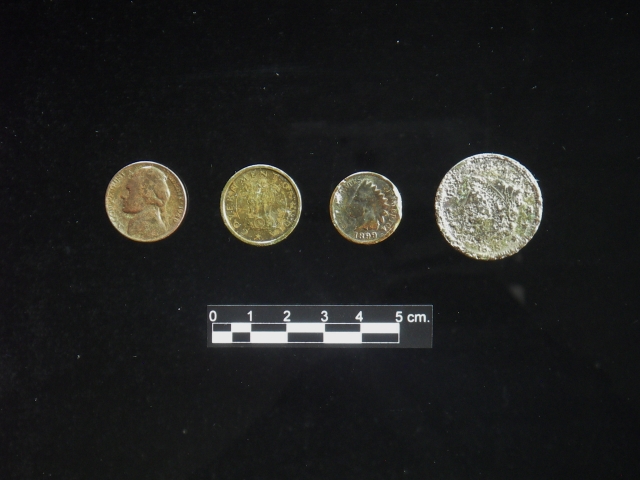  Davids I ExpAmmo ExamplesExamples of expended ammunition found during the 2005-2006 archeological survey. Left to right are a .32-caliber slug, a .50-caliber cartridge, a Minié ball, and a .45-caliber slug. The Minié ball dates to or shortly after the Civil War; the other artifacts are from the late 19th or 20th centuries. 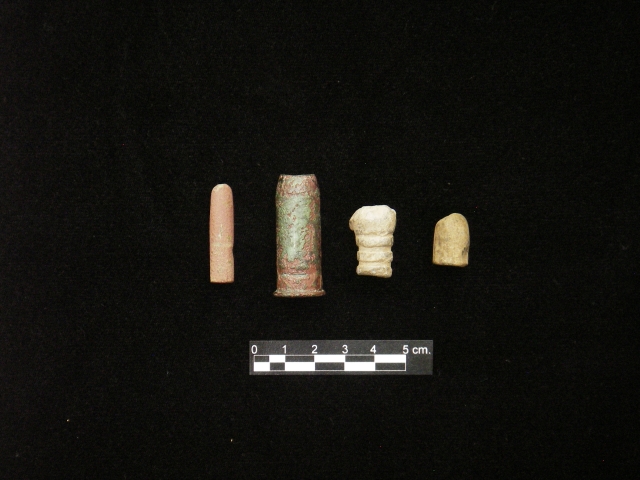  Davids I Smoke Pipe ExamplesExamples of fragments of 19th-century smoking pipes recovered during the 2005-2006 archeological survey of Davids Island, including pieces of pipe bowls and stems with cast decorations (top row) and an unglazed kaolin pipestem stamped "McDougall", a manufacturer who was located in Glasgow, Scotland (bottom). 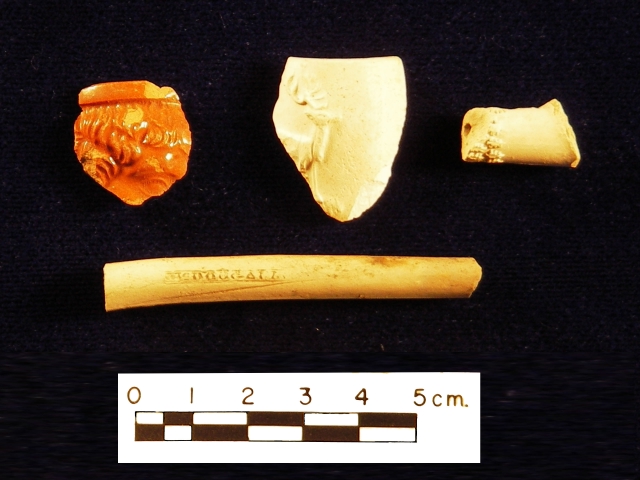  Davids I Toy SoldiersSmall plastic toy soldiers dating to the 1950s or 1960s found during the 2005-2006 archeological survey of Davids Island. 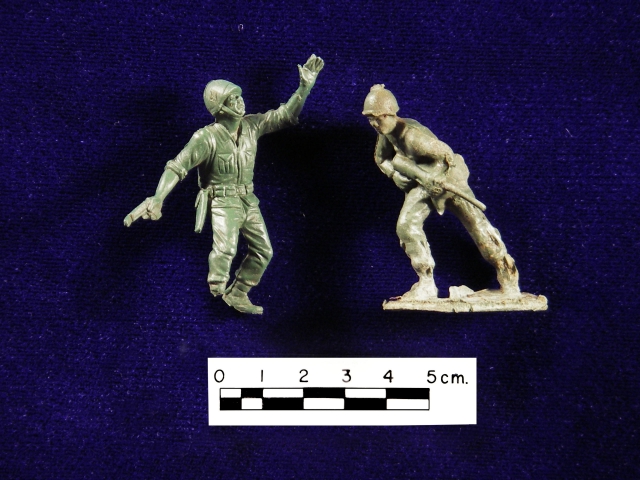 
For the most part, the historic artifacts recovered during the archeological survey of Davids Island were typical of those that might be excavated in many historic residential areas in the northeastern U.S. Although there are occasional items that are specifically military in nature, like buttons, clasps, and expended small arms ammunition, the artifacts recovered by the archeological investigations were not generally military in character.
Some periods of history were not well represented by the recovered artifacts. For instance, there were only the most tantalizing traces of evidence—such as one fragment of a particular type of pottery—that might relate to the use of Davids Island before about 1862 when the Army arrived. Evidence specifically of the Civil War occupation of Davids Island was also not easy to recognize. Artifacts likely to specifically date to the Civil War included one bullet and one button. Some other artifacts recovered by the surveys might also be from the Civil War period on the island, but the objects cannot be dated with enough precision to confirm this possibility.
Most historic artifacts recovered during the archeological investigations on Davids Island probably relate to the major period of development of Fort Slocum between about 1880 and 1940. Several factors are probably responsible for the dominance of this period in the archeological record:
- During this period nearly every part of the island had at least one full cycle of building construction, demolition, and renewed development. Each cycle reworked a piece of the landscape and produced some of the architectural debris that dominates the archeological record.
- The Army used the island most intensively during this period. The sheer numbers of service personnel—often several thousand at a time—increased the likelihood that objects would be discarded, lost or abandoned in all areas of the island.
- By the end of the period there was a well-developed system for the removal and disposal of trash. Regular trash collection and incineration reduced the quantity of objects entering the archeological record.
|
















 Historic Artifacts
Historic Artifacts
